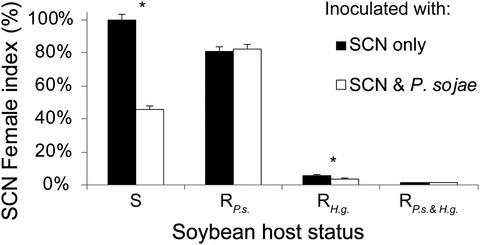当前位置:
X-MOL 学术
›
Plant Pathol.
›
论文详情
Our official English website, www.x-mol.net, welcomes your
feedback! (Note: you will need to create a separate account there.)
Co‐infection of soybean plants with Phytophthora sojae and soybean cyst nematode does not alter the efficacy of resistance genes
Plant Pathology ( IF 2.3 ) Pub Date : 2020-07-06 , DOI: 10.1111/ppa.13227 Carolane Audette 1 , Richard R. Bélanger 2 , Benjamin Mimee 1
Plant Pathology ( IF 2.3 ) Pub Date : 2020-07-06 , DOI: 10.1111/ppa.13227 Carolane Audette 1 , Richard R. Bélanger 2 , Benjamin Mimee 1
Affiliation

|
The soybean cyst nematode (SCN) Heterodera glycines and the oomycete Phytophthora sojae are among the most damaging pathogens of soybean worldwide. Resistant cultivars are commonly used to manage these diseases. As it is known that the presence of SCN can facilitate the development of other pathogens, it is important to verify if there is a synergistic activity between SCN and P. sojae. The purpose of this study was to evaluate a possible interaction on susceptible and resistant soybean lines. The plants were inoculated with one or both organisms at different stages (5 or 10 days old). Two levels of SCN inoculum (2,000 and 10,000 eggs/plant) and different timing between SCN and P. sojae inoculation (2, 5, or 8 days) were compared. The results on 5‐day‐old plants showed that SCN did not influence P. sojae development. The resistant cultivar to P. sojae remained effective (0% mortality) and susceptible cultivars exhibited high mortality (100%) in the presence or absence of SCN. Experiments on 10‐day‐old plants showed that SCN resistance was not affected by the presence of P. sojae. SCN inoculum density and timing of P. sojae infection did not affect the virulence of these pathogens and the efficacy of resistance genes. However, the number of SCN cysts was decreased by more than 50% (p < .001) when P. sojae was coinfesting the susceptible cultivar. This suggests that P. sojae might indirectly influence SCN development by reducing the root mass. This study confirmed that resistant cultivars remain a valid option for the management of P. sojae and SCN.
中文翻译:

大豆疫霉和大豆胞囊线虫共感染大豆植物不会改变抗性基因的功效
大豆胞囊线虫 (SCN) Heterodera 甘氨酸和卵菌 Phytophthora sojae 是世界范围内对大豆最具破坏性的病原体之一。抗性品种通常用于管理这些疾病。众所周知,SCN 的存在可以促进其他病原体的发展,因此验证 SCN 和大豆假单胞菌之间是否存在协同活性非常重要。本研究的目的是评估易感和抗性大豆品系之间可能的相互作用。在不同阶段(5 天或 10 天)用一种或两种生物体接种植物。比较了两种水平的 SCN 接种物(2,000 和 10,000 个卵/植物)以及 SCN 和大豆疫霉接种之间的不同时间(2、5 或 8 天)。对 5 日龄植物的结果表明 SCN 不影响大豆疫霉的发育。对 P 的抗性品种。在 SCN 存在或不存在的情况下,大豆仍然有效(0% 死亡率)并且易感品种表现出高死亡率(100%)。对 10 日龄植物的实验表明 SCN 抗性不受大豆疫霉存在的影响。SCN 接种密度和 P. sojae 感染时间不影响这些病原体的毒力和抗性基因的功效。然而,当大豆疫霉共感染易感品种时,SCN 包囊的数量减少了 50% 以上 (p < .001)。这表明 P. sojae 可能通过减少根质量间接影响 SCN 的发育。该研究证实,抗性品种仍然是管理大豆疫霉和 SCN 的有效选择。对 10 日龄植物的实验表明 SCN 抗性不受大豆疫霉存在的影响。SCN 接种密度和 P. sojae 感染时间不影响这些病原体的毒力和抗性基因的功效。然而,当大豆疫霉共感染易感品种时,SCN 包囊的数量减少了 50% 以上 (p < .001)。这表明 P. sojae 可能通过减少根质量间接影响 SCN 的发育。该研究证实,抗性品种仍然是管理大豆疫霉和 SCN 的有效选择。对 10 日龄植物的实验表明 SCN 抗性不受大豆疫霉存在的影响。SCN 接种密度和 P. sojae 感染时间不影响这些病原体的毒力和抗性基因的功效。然而,当大豆疫霉共感染易感品种时,SCN 包囊的数量减少了 50% 以上 (p < .001)。这表明 P. sojae 可能通过减少根质量间接影响 SCN 的发育。该研究证实,抗性品种仍然是管理大豆疫霉和 SCN 的有效选择。当大豆疫霉共感染易感品种时,SCN 包囊的数量减少了 50% 以上 (p < .001)。这表明 P. sojae 可能通过减少根质量间接影响 SCN 的发育。该研究证实,抗性品种仍然是管理大豆疫霉和 SCN 的有效选择。当大豆疫霉共感染易感品种时,SCN 包囊的数量减少了 50% 以上 (p < .001)。这表明 P. sojae 可能通过减少根质量间接影响 SCN 的发育。该研究证实,抗性品种仍然是管理大豆疫霉和 SCN 的有效选择。
更新日期:2020-07-06
中文翻译:

大豆疫霉和大豆胞囊线虫共感染大豆植物不会改变抗性基因的功效
大豆胞囊线虫 (SCN) Heterodera 甘氨酸和卵菌 Phytophthora sojae 是世界范围内对大豆最具破坏性的病原体之一。抗性品种通常用于管理这些疾病。众所周知,SCN 的存在可以促进其他病原体的发展,因此验证 SCN 和大豆假单胞菌之间是否存在协同活性非常重要。本研究的目的是评估易感和抗性大豆品系之间可能的相互作用。在不同阶段(5 天或 10 天)用一种或两种生物体接种植物。比较了两种水平的 SCN 接种物(2,000 和 10,000 个卵/植物)以及 SCN 和大豆疫霉接种之间的不同时间(2、5 或 8 天)。对 5 日龄植物的结果表明 SCN 不影响大豆疫霉的发育。对 P 的抗性品种。在 SCN 存在或不存在的情况下,大豆仍然有效(0% 死亡率)并且易感品种表现出高死亡率(100%)。对 10 日龄植物的实验表明 SCN 抗性不受大豆疫霉存在的影响。SCN 接种密度和 P. sojae 感染时间不影响这些病原体的毒力和抗性基因的功效。然而,当大豆疫霉共感染易感品种时,SCN 包囊的数量减少了 50% 以上 (p < .001)。这表明 P. sojae 可能通过减少根质量间接影响 SCN 的发育。该研究证实,抗性品种仍然是管理大豆疫霉和 SCN 的有效选择。对 10 日龄植物的实验表明 SCN 抗性不受大豆疫霉存在的影响。SCN 接种密度和 P. sojae 感染时间不影响这些病原体的毒力和抗性基因的功效。然而,当大豆疫霉共感染易感品种时,SCN 包囊的数量减少了 50% 以上 (p < .001)。这表明 P. sojae 可能通过减少根质量间接影响 SCN 的发育。该研究证实,抗性品种仍然是管理大豆疫霉和 SCN 的有效选择。对 10 日龄植物的实验表明 SCN 抗性不受大豆疫霉存在的影响。SCN 接种密度和 P. sojae 感染时间不影响这些病原体的毒力和抗性基因的功效。然而,当大豆疫霉共感染易感品种时,SCN 包囊的数量减少了 50% 以上 (p < .001)。这表明 P. sojae 可能通过减少根质量间接影响 SCN 的发育。该研究证实,抗性品种仍然是管理大豆疫霉和 SCN 的有效选择。当大豆疫霉共感染易感品种时,SCN 包囊的数量减少了 50% 以上 (p < .001)。这表明 P. sojae 可能通过减少根质量间接影响 SCN 的发育。该研究证实,抗性品种仍然是管理大豆疫霉和 SCN 的有效选择。当大豆疫霉共感染易感品种时,SCN 包囊的数量减少了 50% 以上 (p < .001)。这表明 P. sojae 可能通过减少根质量间接影响 SCN 的发育。该研究证实,抗性品种仍然是管理大豆疫霉和 SCN 的有效选择。











































 京公网安备 11010802027423号
京公网安备 11010802027423号